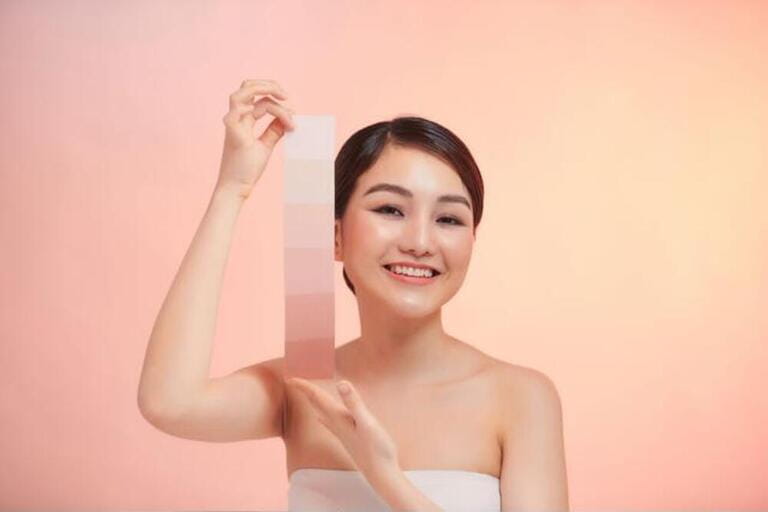It's difficult to put together a wardrobe when you don't know what colors would look good on you. Knowing how different colors look against your skin will help you choose garments that bring out your best features while avoiding those that clash.
If you want to stand out from the crowd, the best clothes to wear are those whose colors complement your skin tone. However, if you wear hues that clash with your skin tone, it can make your hair and complexion look lifeless or even sickly.
This article will help you determine your skin tone and choose the best colors to complement it so that you may always look your best.
UNDERTONING RECOGNITION
Finding apparel that complements your skin tone is essential when stocking a closet. It's crucial to remember that the undertone of your skin is distinct from the surface tone, or how you often define your skin color. It's more important to choose garments that highlight your skin's undertone than its surface tone when trying to find a good match.
Despite the many variations in skin tone, there are only three main categories: warm, cool, and neutral. Yellow undertones are associated with warm skin tones, while pink undertones are associated with cold skin tones. Both warm and cool tones can coexist in a neutral complexion. Your skin's undertone is unaffected by tanning, even if the top layer of your skin takes on a new shade.
Here's how to tell if your skin has a warm or cold undertone:
Check your veins regularly
Check your veins as a starting point in determining your skin color. Thinner skin means that blood veins in places like the elbows, temples, and wrists are closer to the surface. It's simpler to discern the veins through the skin and identify their hue on those with lighter skin tones.
Try to find some bluish or a greenish vein. If your veins are blue, your skin is on the cool side, and if they're green, you're on the warm side. If you can't tell if your veins are green or blue, your skin tone is most likely neutral.
Have the Paper Exam
Try the white paper test if you have doubts or can't see your veins. Put a sheet of white paper up to your skin and see what colors jump out at you. Your skin tone can be estimated using these hues.
Hold the paper close to your chest or throat rather than your face. Facial redness, brought on by factors like sun exposure, can skew the perception of skin tone.
Put the white paper up against your body and take note of the colors that pop against the background. You have a cool skin tone if pink and blue show up, while a warm skin tone if gold and green do. A neutral skin tone may show different shades at different times of the year and in different lighting conditions.
Think about how your skin reacts to sunlight
A cool skin tone is more common in those who are prone to getting sunburns, especially in the summer. Warm-skinned people, on the other hand, tend to tan rather than burn. You might have a neutral tone if you never get sunburned and don't get a tan. When sunburns quickly turn into a tan, you have a neutral skin tone.
Don't test this by deliberately going out into the sun to see whether you get a burn. Consider instead how your skin has responded in the past. Your question has been answered if you rarely get a sunburn.
REALIZING THE CHANGE OF THE SEASONS

Seasons with a Chilly Mood
The chilly tones of summer and winter share a lot of other similarities. There are, nevertheless, subtle differences between them that a dapper gentleman should be aware of.
In the summer, this skin tone will show pink, red, or blue undertones on the white paper test. Those who have a summer complexion will have hair and eye colors that contrast with it subtly.
The white paper test will reveal the same pink, red, or blue undertones for persons with a winter skin tone. Those who have a winter complexion, on the other hand, will have eye and hair colors that stand in striking contrast to their skin. A person with black hair and very fair skin has a winter skin tone.
HONEYCOMB TIMES

The white paper test will reveal a spring skin tone if you look for hints of peach, cream, and gold. Most springs have rosy cheeks, freckles, and blue or green eyes in addition to their strawberry red or straw hair.
Season of Autumn: A white paper test will reveal any yellow or golden undertones for those with an autumn skin tone. The hair and eyes of autumns are often darker than those of springs.
Shades Suitable for Fair Skin
Colors on the cooler end of the spectrum work best with cool skin tones. Emerald, deep purple, lavender, pink, icy blue, and dazzling blue are all recommended hues. Use very light yellows, rose reds, and rubies if you want to add a warmer shade to your outfit. White, gray, and blue are some of the more neutral colors that can be used.
The thought process behind these color choices was to create a visually pleasing contrast with your fair complexion. Since having a cool skin tone usually means having fair skin or delicate features, you probably gravitate toward darker hues. Colors like emerald green, navy, and bright colors of blue tend to be the most flattering against fair complexion.
Rather than wearing warm metals like gold or copper, choose watches and other jewelry made from platinum or silver. Avoid wearing orange, powerful yellow, and tomato red as well. You won't look your best wearing these hues since they clash with your skin tone.
Further, you can choose colors that go well with your seasonal skin during the different months. Wearing clothes from the opposite cool-toned season tends to look better than warm-toned clothing, but if you want to play it safe, you should stick to the colors associated with your season. Some tips, whether you have summer or winter skin:
Softer colors are preferable to more brilliant ones in the summertime. Pale blue and lilac, as well as gentler neutral tones with rose undertones, are some colors to work with. In the summer, pastel colors are also a popular choice.
Clothing with timeless pink and blue hues looks great on Winters. When they wear strong colors like navy blue, white, or black, they stand out even more.
COMPATIBLE COLORS WITH WARM SKIN TONES
If you have a warm skin tone and are looking for the right colors to wear, your search is over. Earthy tones look great on people whose skin is naturally on the warmer side. Green, brown, mustard yellow, and deep red are some of the best hues for those with warm skin tones. You can also play around with various warm-toned colors like peach, coral, amber, and gold. Choose olive, orchid, violet-red, and moss for warmer tones of chilly hues to incorporate into your wardrobe.
It's also interesting to try neutral colors. Cream, beige, taupe, mushroom gray, and cappuccino are all examples of soothing neutrals that work well with warm complexion tones. When it comes to color, warmer skin tones tend to look best in earthy tones.
Silver and platinum are too cold for watches and men's jewelry, so go for gold and copper instead. Gold is the best option because it complements your skin tone, while platinum and silver are fine for special occasions. If you want to avoid looking washed out and a little gray, stay away from colors with ice blues or jewel tones.
Pick out seasonal colors to add flair to your wardrobe. The most popular colors this season include:
There is nothing more beautiful than a springtime in shades of yellow, orange, peach, coral, or ochre. Spring is the time to wear gold jewelry.
Colors like caramel, green, beige, tomato red, and coffee are perfect for this season. In the same way that springs can accessorize with gold, autumns can also wear copper and bronze.
Colors that look well on fair skin
The fashion world is yours for the taking if your skin tone is neither too warm nor too cool. You can look great in colors that work with either warm or cold undertones. The full selection of colors at your disposal will allow you to stand out in any setting.
Although most colors work well with fair skin, those with darker skin should stick to more neutral tones like jade green and soft pink when dressing. Also, remember that you don't have to wear every single hue in your closet all at once while putting together an outfit. Choose complementary and muted tones to offset a statement color like cobalt blue.
Wearing brown tones might make your clothing disappear into your skin. Since people with neutral skin tones tend to have darker complexion, brown apparel may not stand out enough.
The colors black and navy are best avoided. These hues are flattering, yet they don't do justice to your multifaceted complexion. Not only will your skin tone look great in brighter tones, but you'll also stand out from the sea of men in black and navy suits. Limiting your use of these hues will help you stand out from the crowd.
EVERY COLOR YOU COULD EVER NEED
Pale pink, bright red, teal, and dark purple are universally flattering colors that can be worn with confidence by people of all complexion tones. Although these hues look great together, you shouldn't show up to the office or a social function sporting them all. Instead, try mixing and matching these colors with the rest of your ensemble and some complementary accessories for a truly unique effect.












